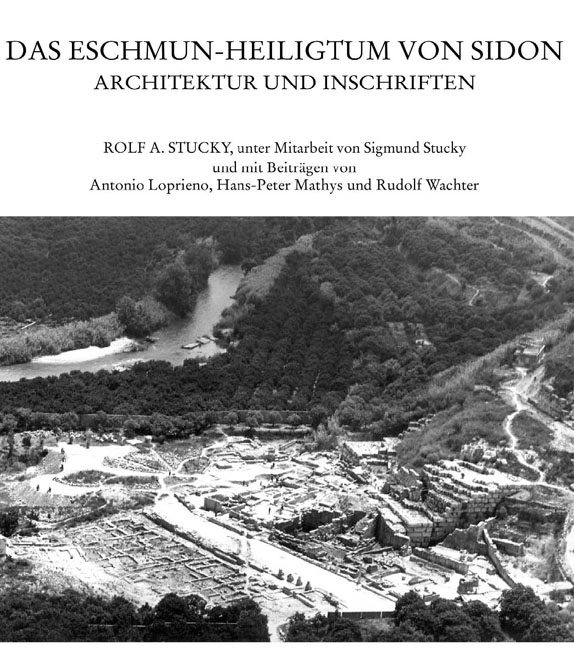Description
DAS ESCHMUN-HEILIGTUM VON SIDON
Architektur und Inschriften
Rolf Stucky, unter Mitarbeit von Sigmund Stucky
mit Beiträgen von Antonio Loprieno, Hans-Peter Mathys und Rolf Wachter
Der phönizische Heilgott Eschmun hatte in den Gärten von Bostan ech Sheiq bei Sidon eines seiner grössten Heiligtümer. Dank der Lage ausserhalb des durch Neubauten bis in grosse Tiefen durchwühlten Stadtgebiets blieb das im 6. Jahrhundert v. Chr. gegründete Eschmun-Heiligtum recht gut erhalten; während des libanesischen Bürgerkriegs sind allerdings die meisten Votivskulpturen, Architekturteile und Inschriften «verschwunden». Die wissenschaftliche Dokumentation der gestohlenen Bauteile und ein Rekonstruktionsversuch ihres ursprünglichen architektonischen Gesamtkonzepts sind das doppelte Ziel dieses letzten Bandes der Grabungspublikation.
Zwei monumentale Podien dominieren bis heute optisch das Heiligtum. Auf ihnen standen einst Toranlagen, Altäre und Tempel. Mit den aus lokalem Kalkstein gearbeiteten Säulenbasen und Löwenwasserspeiern folgt der Tempel des späten 6. oder frühen 5. Jahrhunderts v. Chr. syro-phönizischen Traditionen. Aus Griechenland importierter, wohl attischer Marmor diente als Baumaterial für den Tempel des frühen 4. Jahrhunderts v. Chr. Im äusseren Erscheinungsbild bot er sich als ionischer Amphiprostylos dar; mit Stierprotomenkapitellen über assyrischen Blattkranzbasen blieb die Cella jedoch der nahöstlichen – mesopotamischen und iranischen – Formenwelt verpflichtet. Gemäss unserem Rekonstruktionsvorschlag ist der klassische Eschmun-Tempel der bisher älteste Vorläufer der berühmten Tempel des Bacchus in Baalbek und des Bêl in Palmyra.
Die ägyptischen, phönizischen und griechischen Inschriften zeigen nicht nur die weitgespannten handelspolitischen und kulturellen Kontakte auf, die Sidon mit der gesamten antiken Welt verbanden, sondern vermitteln auch Einblicke in die phönizische Götterwelt und in Riten und Organisation des Eschmun-Kultes.
One of the most important sanctuaries of the Phoenician healing god Eshmun lies in the gardens of Bustan esh Sheikh near Sidon. It was founded in the sixth century b.c. Due to its situation at some distance from the city – where construction work has disturbed the ancient remains in great depth – the sanctuary is fairly well preserved. During the Lebanese civil war, however, most of the votive sculptures, architectural blocks and inscriptions disappeared. This volume, the last of the three excavation reports, presents an extensive documentation of the stolen architecture and inscriptions and offers a reconstruction of the original architectural concept of the sanctuary.
Two monumental podiums still dominate the sanctuary. They originally supported gateways, altars and temples. The temple of the late sixth or early fifth century b.c., with its column bases and lion gargoyles fashioned from local limestone, follows Syro-Phoenician traditions. For the temple of the early fourth century b.c., Greek marble was imported, probably from Attica. Its exterior resembles an Ionic amphiprostylos, but the cella, with bull head capitals and Assyrian type bases, remained true to Near Eastern – Mesopotamian and Iranian – forms. If the reconstruction proposed here is valid, the Classical temple of Eshmun is the oldest known precursor of the famous temples of Bacchus in Baalbek and Bêl in Palmyra.
The Egyptian, Phoenician and Greek inscriptions not only testify to the extensive commercial and cultural contacts which Sidon entertained with the ancient world, but also provide an insight into Phoenician religion, specifically the rites and organisation of the Eshmun cult.
Echmoun, dieu guérisseur des Phéniciens, avait un de ses plus importants sanctuaires près de Sidon, dans les jardins de Bostan ech Sheiq. Fondé au 6e siècle av. J.-C., ce sanctuaire d’Echmoun se trouve dans un assez bon état de conservation: situé en dehors de l’agglomération urbaine, il a de ce fait échappé aux dégâts causés jusque dans les couches profondes par les constructions plus récentes. Notons toutefois que durant la guerre du Liban, la majeure partie des sculptures votives, des éléments architectoniques et des inscriptions a «disparu». Ce volume, le dernier de la publication des fouilles, poursuit un double but: présenter toute la documentation scientifique sur les éléments architecturaux et les inscriptions dérobés et proposer une reconstitution du concept architectonique général tel qu’il pouvait être à l’origine.
Deux podiums monumentaux dominent aujourd’hui encore le sanctuaire. C’est là que s’élevaient, à l’origine, des propylées, des autels et des temples. Le premier temple remonte à la fin du 6 e ou au début du 5 e siècle av. J.-C.; avec ses bases de colonnes et ses gargouilles en forme de lion, sculptées dans le calcaire local, il suit les traditions architecturales syro-phéniciennes. Le temple du début du 4e siècle av. J.-C., quant à lui, est construit en marbre importé de Grèce, peut-être d’Attique. Vu de l’extérieur, il se présentait comme un temple amphiprostyle d’ordre ionique; la cella, toutefois, dont les colonnes portaient des chapiteaux à protomés de taureau et reposaient sur des bases de type assyrien restait fidèle à un univers formel proche-oriental, d’origine mésopotamienne et iranienne. Si l’on suit notre proposition de reconstitution, le temple classique d’Echmoun est le plus ancien prédécesseur connu du fameux temple de Bacchus à Baalbek et de celui de Bêl à Palmyre. Les inscriptions égyptiennes, phéniciennes et grecques mettent en évidence l’expansion et la richesse des contacts commerciaux et culturels que Sidon entretenait dès le 5 e siècle av. J.-C. avec l’ensemble du monde antique; elles nous permettent également d’entrer dans le monde divin phénicien, et offrent un aperçu des rites et de l’organisation du culte d’Echmoun.
Gebunden/hardcover 22,5 x 28 cm
300 Seiten, 60 Bildtafeln, zahlreiche Strichzeichnungen und Pläne
300 pages, 60 plates, numerous plans and drawings
ISBN 3-909064-19-1

